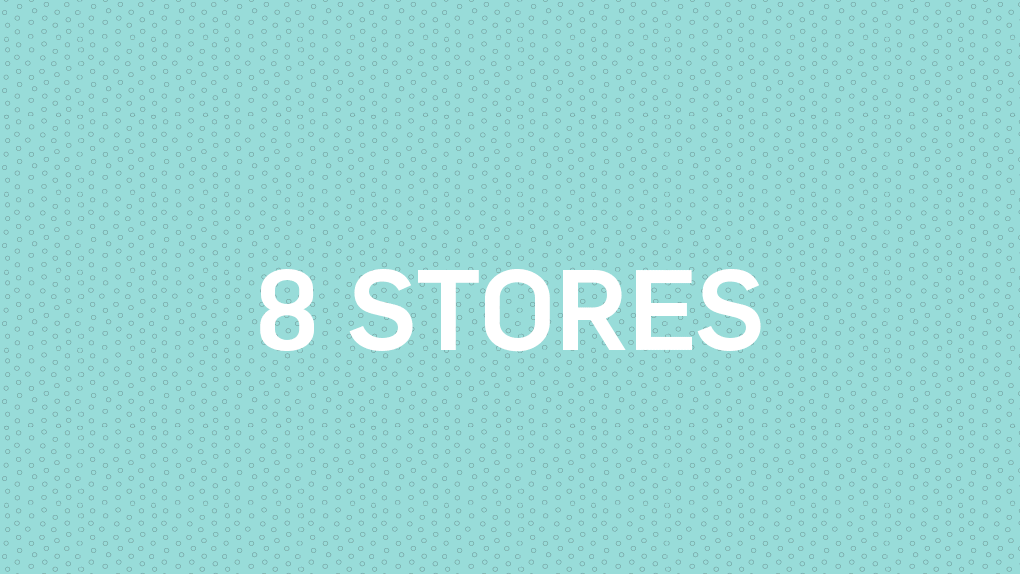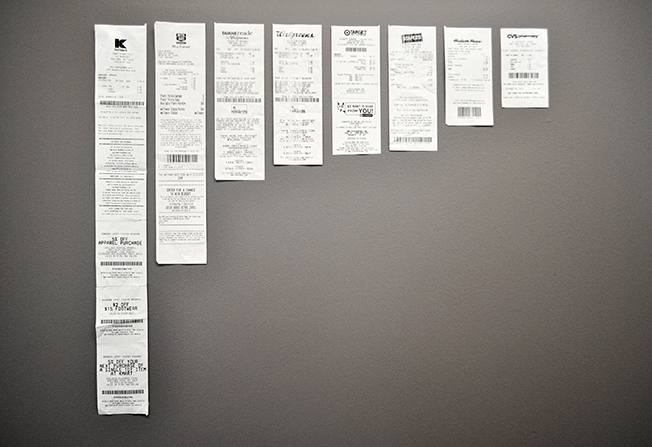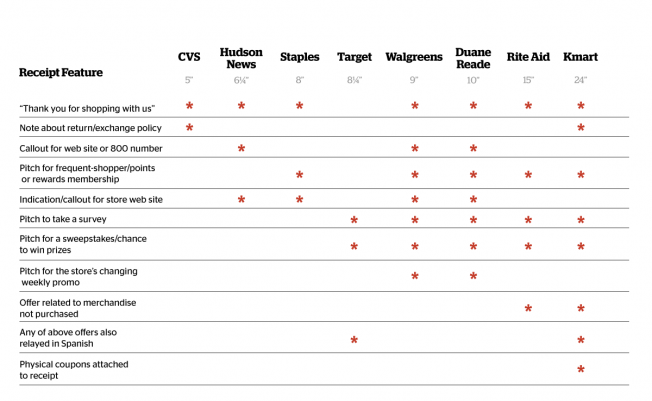
Over at Adweek.com, Robert Klara decided to see how long of a receipt he would get at some major retailers by buying only a pack of gum.
The results of his little test shocked me, as CVS finished LAST of the 8 he tested. I’m guessing he didn’t have an ExtraCare card as usually they are quite long, but it turned out KMart was #1 by far. While I doubt anyone goes into a KMart and walks out with only a pack of gum, (In fact, does anyone even go into a KMart any more?) it does point out how wasteful and ridiculous it can get at times.
Some of the stores I frequent are now giving you a choice at the checkout of paper receipt, email receipt or no receipt at all. Obviously they are dying to get your email and hope you choose that one, but unless it’s a big-ticket purchase I’m going to select none since I’ll probably toss the receipt anyway. Many retailers (such as Staples) can pull up your receipt for you if you used a credit card anyway, so I foresee it won’t be long before they are gone altogether, or perhaps you will just “opt-in” if you want a paper receipt whenever you shop somewhere but the default will be none at all. On the other hand, what’s that little old lady who wants to double-check everything to make sure you charged her correctly on everything going to do? I guess she’s not opting in…
As shoppers troop off to buy gifts for the holiday season, ringing up an estimated $877 billion, most of them will go home not just with their purchases, but also with a paper receipt in the bag.
Often, it’s a very a long paper receipt in the bag.
American retailers crank out 1.4 billion pounds of paper receipts each year, and the sometimes staggering length of them has led to plenty of ranting. A diatribe in The Atlantic a few years back called long receipts a “creeping sign of postmodern malaise,” and a problem that’s “been swirling out of printers and control for too long.” Earlier this year Jimmy Kimmel pledged to make it his “life’s mission” to demand shorter receipts. “You go to the drug store now, you buy one or two things, you get a receipt that’s like a Miss America sash,” complained the show host, who went so far as to ask President Obama if he could do anything to make receipts shorter.
It’s one thing to get a gangling receipt for a cartful of groceries, but these complaints center on registers that spit out huge receipts even for small purchases.
And that prompted us to do a little field experiment.
Selecting the most modest purchase imaginable—a pack of Trident spearmint gum—we set out to eight national chains, bought the gum and then measured the receipts we got. (To keep all variables equal, we bought only the one item, paid in cash and used no rewards cards.)

Kmart clocked in with the longest receipt at 2 feet, while the shortest (5 inches) belonged to none other than CVS (possibly the result of the online scalding the chain took over its mile-long receipts a few years ago.)
So what was taking up so much space for such a modest purchase? Our complete results, including the measured lengths, appear in the chart below:
Why are store receipts so damned long?
The reason for receipt puffery certainly isn’t because the register people really dig changing out those paper spools. It’s because many retailers still view paper receipts as marketing tools. As a general rule of thumb, the more marketing tactics a store decides to stuff onto its receipt, the longer that receipt will be.
This is why our longest receipts packed in every promo imaginable—not just the usual shopper survey and rewards membership offers, but sweepstakes, special offers, discounts and coupons. These add-ons are what stretched Kmart’s receipt to a stunning 2 feet, Rite Aid’s to 15 inches, and Walgreen’s and Duane Reade (owned by the same company) to 9 and 10 inches, respectively.
Kmart, Duane Reade and Walgreen’s did not respond to our requests for comment. But Rite Aid, which had the second-longest receipt we collected, told Adweek that “we have worked diligently over the years to make sure our register receipt are both purposeful and appropriate in terms of length.” The store added that it views paper receipts as “a way to communicate relevant product offers and information” to its customers.
But with so many of those consumers annoyed about the length of receipts, do these old-fashioned callouts really work anymore? Did they ever work?
“The receipt is the final contact the store has with the customers and, to the extent they can extend that contact, there’s value there,” said John Deery, principal with retail POS providerJ.D. Associates. “The printed receipt is an old call to action, but it can still get you to come back and spend money.” Deery concedes that a 2-foot long receipt for a pack of gum is “kind of funny,” but “do you go back because of the coupons? You may.”
A tool to bring you back (and mine your data)
“What all these retailers are trying to do is engage the consumer to come back for a second trip,” added Ken Morris, principal with Boston Retail Partners. Like Deery, Morris said that receipts larded with callouts and aflutter with coupons are “sort of old school,” and added that, in his experience, many customers simply don’t pay attention. “It’s got to be over half the people who don’t want the receipts—they throw them away,” said Morris, who counts himself in that group. “The only receipts I take are from restaurants—and I still throw them away. It’s ridiculous.”
But even though those callouts on the receipt to take a survey of your shopping experience have a very low response rate—as little as 2 percent to 3 percent—Morris said the data that retailers get is incredibly valuable to them. “I personally know a number of my clients use customer feedback, and bonuses at the store level are based on that feedback,” he said. “They take that very seriously.”
Meanwhile, consumers tired of registers spitting out receipts that are, to quote Jimmy Kimmel, as long as a Miss America sash, will probably get relief—eventually. Electronic receipts are slowly but steadily taking over, and retailers like them for many reasons. E-receipts not only give retailers access to customers’ personal e-mail addresses, but they offer many ways to up-sell and cross-sell and act as portals to a brand’s social media channels. A Boston Retail Partners poll this year showed that while only 10 percent of retailers offer personalized e-receipts now, 35 percent plan to add them in the next 12 months.
Still, the pace of change is slow, and consumers’ lingering attachment to paper probably means that receipts—including really long ones—are likely to stay with us a while longer. “There are some people who have been predicting the demise of cash, too, and cash is alive and well,” Deery said. “I don’t see it as the end of the paper receipt.”

